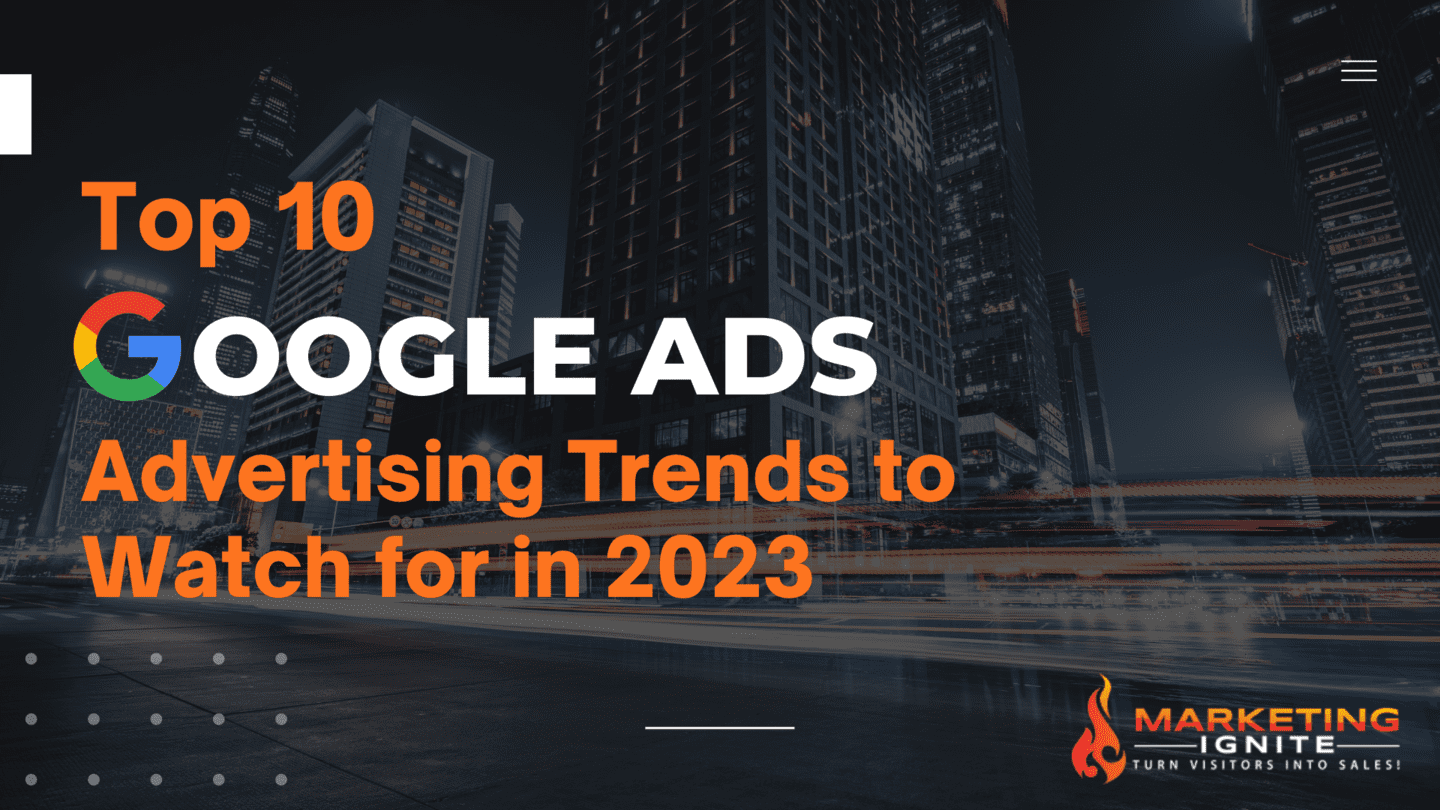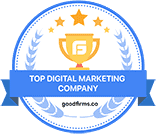
Every time the ranking algorithm of Google gets modified, a digital marketer cringes. It's par for the course though. They have to watch out for it because every small change can result in massive traffic volume plummets in a few hours.
It also means that Google has made its algorithm smarter than before. They change it not to punish its users or even to weed out spammers but instead to ensure every search result is user-friendly and relevant.
In regards to Google Ads trends, it's the same song and dance. The advertising platform is modified to empower you, the digital marketer. The tech giant wishes to make sure its advertisers get their money's worth.
On that note, it's best to keep abreast with these latest changes and emerging trends in Google Ads, what it means for your company, and how you can go about using them to your advantage.
What are the Top 10 Google Ads Trends in 2023?
Let's now talk about the latest Google Ads trends and changes to watch out for during 2023.
1. Cost Per Lead Increases
Just a head's up. The cost per lead has increased nearly across the board for 91 percent of all industries. That's practically all of the industries save for about 9 percent of them. This is in accordance with a recently released Google Ads benchmark report by WordStream.
The Increases All Over the Map: The industries for Furniture (54 percent), Travel (69 percent), and Arts/Entertainment (134 percent) got immense increases while the overall average increase across the board is about 19 percent. Brace yourself if you're in any of those top three (in terms of increases) industries.
What's with the Increase? Inflation is the culprit for the cost per lead, with some industries more dependent on Google Ads lead generation than others. There are also certain adverts that show up for low commercial intent queries that increase CPL and decrease conversion rates.
Lower Your CPL in 2023: Use the recommendations of us here at Marketing Ignite to help adjust your campaign and your ad spend to adapt to the specific trends above. This should help lower your CPL since trends tend to ride popularity waves that make lead generation much less of a hard sell proposition.
Full-Funnel Strategies to Adopt: We will also assist you in making a full-funnel strategy with efficient keyword targeting and ad optimization in mind. We'll even go about negative keyword list maintenance for your convenience for good measure.
Marketing Ignite provides many tips to lower Google Ads CPL regardless of the state of inflation in the country and in the world. If you belong to an industry with high search volumes, prepare for a bit of a balancing act between ad spend and following ad trends.

2. Target ROAS Bidding
Different campaign formats require different bidding strategies so that you get a better ROAS result. Target ROAS is one particularly effective strategy that allows you to bid based on your predicted average conversion value as opposed to the predicted conversion rate.
What is ROAS and Why Do You Need to Target It? ROAS refers to Return on Ad Spend. This key performance indicator (KPI) shows you the amount of revenue you've earned for every dollar you've invested into your Google Ads campaign.
Video Action Ads and Discovery Campaigns Were Exceptions: You might need to target your ROAS bidding for specific advertisement campaigns. You used to be able to avail of this Google Ads trend of "Target ROAS" or "tROAS" for most types of campaign except for Video Action and Discovery Ads campaigns.
Now Available for Video Action Ads and Discovery Campaigns: You can now apply tROAS to Video Action and Discovery Ads campaigns. On that note, these campaigns should meet the requisites of tROAS bidding:
Recommended Starting Point: You can utilize the average ROAS from existing campaigns on Google Ads as your place to start. You should spend about twice your daily budget to collect the info needed to make tROAS bidding effective.
Video Action Campaign Requirements: You should set values for the conversions being tracked. For example, you need to generate at least 15 conversions in the past one month or 30 days.
Discovery Campaign Requirements: You need to generate at least 75 conversions in the past one month or 30 days. Ten of such conversions should happen in one week or 7 days.

3. Image Assets or Extensions
Digital marketers in the past until recently could only make search ads through text on Google Ads. This is in stark contrast to YouTube or Facebook, which have more image-based search ads. It makes Google Ads look outdated or antiquated.
Back in July 2020, Google launched the beta program for image assets in search-based advertisements. They're clickable images and have the same price as text-based ads. However, the use of images encourages more clicks compared to plain text.
Upload Up to 20 Clickable Images: You can upload up to 20 images related to keyword bids you've made. Don't forget to follow their strict requirements in terms of formatting and image types. Every image must be approved manually too before they can become campaign-available.
The Numerous Benefits of Having Image Assets: On average, you can get up to a 10 percent increase in your click-through rate when using mobile search ads image assets. This is according to Google Internal Data from March 5-18, 2021.
Images Extend Search Ads to New Platforms: Image extensions for searchable ads extend them to new platforms. In turn, they're able to have a wider consumer reach because the images can be used on YouTube Search through the Search Partner Network (AFS).
A Picture-Based Ad is Worth a Thousand Text-Based Ads: Image assets are also able to visually convey info that you can't convey via text. Additionally, when your image assets appear on Google SERPs, your customers can see your image, your URL, your descriptions, and your headlines.
4. Shopify Integration
Shopify has grown into a huge e-commerce juggernaut in just a few years. As digital marketers, you want to integrate Shopify into your campaign in order to ride its wave of influence and relevancy in the digital marketing world.
Using Shopify and Google Ads in Perfect Synergy: Google thusly introduced this new trend of adding Shopify integration to its Google Ads platform. If you're using both Shopify and Google Ads, you should be able to merge both in perfect synergy.
How the Integration Works: Long story short, Google Ads can now use Shopify store data from users with the "Customer Match" feature. Merchants can directly utilize existing store data to match customers and gain better metrics and conversions.
Shopping Graph: You can use the Shopping Graph to pull data like product info, videos, and prices from all over Google's platforms to tell your users who shop with Shopify who's the merchant available with the best prices, how well items were received, and where to find different items in general.
Free Merchant Promotion: Surely businesses and digital marketers can use the Shopping Tab with Google Ads in order to allow merchants to freely promote their products in a way that leads to lead conversion and a buying decision from online ordering to offline reception and so forth.
The Shopify integration basically enables merchants to run ads on every Google property with enhanced results rooted in Shopify's influence as a popular and trusted e-commerce solution for advanced store management.
You simply need to connect your Google Ads manager account with your Shopify serving account. Just check if you have enough Shopify store data to enable Customer Match. Otherwise, collect more data until the option is open to you.
5. Product Feeds for Video Action Campaigns
If you're utilizing video advertisements or "Internet commercials" to promote your company, e-shop, or e-commerce business, there's some good news for you! Google has put together what's known as "product feeds" for your Video Action campaigns.
Internet advertising has taken cues from print ad and television advertising, but developers of such apps and algorithms quickly realized it's only tapping into part of their potential.
Online ads can do way much more than their static counterparts because they're online and interactive. Here's how the product feed works.
The Feed Appears After a Few Seconds into the Video Ad: When a user sees the video ad promoting your wares, YouTube will show a panel below after a few seconds. This panel shows your different available products.
Works Only in Portrait Mode: This feature only works when your phone is in portrait mode instead of landscape mode. Luckily, most people watch videos with their smartphones upright instead of tilted to the side to emulate PC monitors.
Direct Link into the Landing Page: When the user chooses a product on the feed, they'll end up on the landing page of the product to give them more info. It also compels them to make a buying decision since the product is already there.
Cuts Down in Conversion Time: If you're an e-commerce digital marketer, this cuts down on conversion time that typically leaves leads into the sales funnel bottleneck. You're also able to appeal more to the impulsive buyers out there depending on how well-targeted the video ad is.
Long story short, the product feed on your video ad is a worthwhile Google Ads trend to hitch your campaign into since it has a huge potential in increasing your sales and improving sales attribution.
6. Enhanced Conversions
Of course you'd want to ride the "Enhanced Conversions" trend for Google Ads as a digital marketer. Even its title sounds promising already. However, what does it entail exactly?
Conversion Attribution Modeling Booster: It's a method of improving your conversion attribution modeling. It grabs consenting first-party data that users offer then hashes the data using the SHA256 algorithm and transmits it via the conversion tag.
Consenting First-Party Data: The first-party data volunteered by users with consent typically includes their name, phone number, address, and email address. This is important data that really helps define your leads.
The Part Where the Magic Happens: Google then matches that conversion data with its signed-in Google accounts using the Enhanced Conversions feature. This enables you to know who's viewing or clicking your ads for demographic or audience targeting purposes.
Anonymous and Aggregated: Google states that the conversions reported by this newest Google Ads feature are aggregated but anonymous. As for manually setting the feature, you can use Google Tag Manager or Global Site Tag to do it.
From Third to First Party: It's recommended that you add Enhanced Conversions ASAP if you're depending presently on third-party data for conversion modeling before it's moved as a first-party data feature somewhere in the middle of 2023.
Having a solid conversion attribution model is important in digital marketing because it allows marketers to pinpoint the channel that led specific users or demographics to perform clicks or views of your ads (leading to a conversion) on a mobile app or website.

7. Instant Customer Match Rates
The "Customer Match" feature for Google Ads is another Google Ads trend or change to watch out for. This feature enables you to utilize your offline and online data for targeting customers across Google channels and other consumers that appear like them.
The Match Rate was Originally Slower: You have to usually wait for the Match Rate to appear when uploading your customer list. To be more specific, the Match Rate is the number of users Google could match from their user base (a la Enhanced Conversions).
New and Improved Instant Match Rate: Since April 2021, the tireless Google engineers have made it so that Customer Match Rates arrive instantly from your past and present uploads instead of you having to wait every time you do a customer list upload.
Another Important Bit of Optimization: This seemingly minor update changes the flow of your Google Ads operation and campaign management. If customer match issues were to arise, you'll be able to find them and solve them faster instead of having them clog up your sales funnel and eat up your work hours.
How to Improve Match Rates: According to Google, you should add as much customer info as possible to ensure better Customer Match Rates when push comes to shove. Digital marketers who upload two customer info types achieve an average list size increase of 28 percent. With three types, they get a 35 percent increase instead.
This improved feature in Google Ads also allows you to figure out what part, channel, site, or action of your Google Ads campaign leads to more conversions, thus giving you even more detailed data straight from the Google user base.
8. New Local Campaigns Formats
Local businesses require local campaigns. They need to appeal to locale-specific customers with their own unique culture, tastes, and references instead of watering-down the campaign to be too generalized or universal.
Keywords with Localities Listed: They specifically need to drive potential customers directly to their local branches or stores. In the past Google Ads campaigns with a local touch were linked to queries such as "best pizza 90210" or "best pizza in California" or "Joe Mama's Pizzeria Fresno".
A New Map-Based Methodology: In the last year or so, back in 2022, Google has added new promotional methods to promote local businesses that make perfect sense—use Google Maps to locate the branches, since it's such a popular smartphone navigation app from Google.
Auto-Suggest Ads with Map Tech: Auto-suggest ads allow you to pay for Google to add your store in the auto-suggest results. If people are looking for Van Nuys pizza, your pizza shop could be on the top of the suggestions. The nearest geolocation trackers should detect your specific shop early on.
Navigational Adverts Based on User Location: The customers' user location can also be used by Google Ads and Google Maps to sell your wares to them in the form of navigational ads. These ads show where your business is on the app like auto-suggest, but this time it activates when customers are near.
Local Inventory Ads: Businesses can sell their wares locally through the Shopping Network with local inventory ads. These products can be available for "curbside pickup", "later pickup" or "pickup in-store today". You can implement this newest type of ad through a Shopping Google Ads campaign.
The traditional way of advertising businesses locally is that the search results and ads will only show to people specifically searching a location and your business. However, with things like navigational adverts, your store is advertised on their Google Maps route even if they're not looking for your company specifically.
9. Conversion Modeling via Consent Mode

In accordance with the General Data Protection Regulation (GDPR), online companies and digital businesses have to use more robust data privacy policies to continue operating legally in the World Wide Web at large, including the multi-billion conglomerate Google and its Google Ads.
Consent Mode: Google launched Consent Mode back in September 2020. It's a method of adjusting Google tags in terms of their behavior based on the website visitor's "consent status". This keeps websites compliant with GDPR law.
New Challenges: Google's GDPR-compliance inadvertently resulted in a new issue for digital marketers. When the user refuses to consent to analytics or ads cookies, Consent Mode adjusts Google tags to not write or read cookies for analytics or adverts. This results in lost visibility and a measurement gap.
Google's Solution: In order to throw digital marketers a bone while still remaining compliant with GDPR law, Google made conversion modeling available with Consent Mode backing since April 2021. This enables digital marketers to recover the attribution path between ad-clicks and conversions.
Ad-to-Click Conversion Data: According to Google, this new expanded Consent Mode recovers 70 percent of ad-to-click conversion data. Digital marketers aren't left in the dark on what happens when users' consent status is negative. They can adjust their marketing to gain consent from visitors.
Machine learning is used by conversion modeling to examine observable information and trends in history. This in turn shows the links and relationships between consenting and non-consenting visitors.
The observable user journeys will then be used to fill in the blanks when it comes to the missing data. This is particularly useful for digital marketers operating in GDPR areas such as the United Kingdom or the European Union.
10. Performance Max Campaigns
What are performance max campaigns? Essentially, every campaign under Google Ads you've ever managed uses the same targeting choices you've defined or set up yourself. To be more specific, you could pick through a list of keywords you wish to make bids for or a set of site placements you wish your ads to pop out of.
First Came Custom Ads: As far as veteran digital marketers are concerned, the strategy offered few downsides. It's not the same deal with novices like entrepreneurs with startup enterprises. Recently, Google began developing newer features that allow for fully automatic advertising to cater to these "newbies".
Then Came Smart Campaigns: This came about specifically with Smart Campaigns. As its name suggests, it dealt with optimization and audience targeting for you like a smartphone digital camera adjusting lighting and focus like an experienced photographer.
Next Comes Performance Max: Performance Max is the next evolution of Smart Campaigns that was released in May 2021. It runs the newest campaigns with little input from the user. You only need to provide the following instead:
The budget for the campaign.
Advert scheduling, language, and location.
The bidding in terms of target value/conversion or max CPA.
The copy, videos, images, and CTA or the advertisement creatives.
CPA, ROAS, and other indicators of your campaign goal or objective.
They're like your company depending on us here at Marketing Ignite to handle all the details, except this time it's Google's own artificial intelligence or algorithm doing the automated advertising customizations for you.
Google came up with these smart or A.I.-based algorithmic campaigns to give amateur digital marketers an option for maximizing advertising potential or allow experienced marketers to run multiple campaigns simultaneously.

Marketing Ignite’s Final Thoughts on Google Ads Trends
We here at Marking Ignite have committed ourselves to guiding you towards efficient use of your Google Ads spend through these many different upcoming Google Ads trends in 2023. It's crucial that we work towards preparing your campaigns for all these changes so you're not caught flat footed with an outdated campaign.
The last thing you want are Google Ads that work against your best interests, create bottlenecks in your sales funnel, and limit the full potential of your lead generation efforts. You want the exact opposite of all of those, while at the same time getting the jump on your competition by adapting to these newest trends.
Get in touch with our Google Ads experts today!







